
FROM TRAITORS TO HEROES
How attitudes to the Chartists have changed
Peter Strong
It is now 181 years since the Newport Chartist Rising. Over the years, the attitudes of local ‘people of influence’ to the Chartists has changed considerably. Whereas first depicted as traitors who sought to plunge the country into bloodshed, now the Chartists are widely seen as heroes in the long struggle to achieve democracy.
The opening of John Frost School in 2015 marks the completion of this transformation.
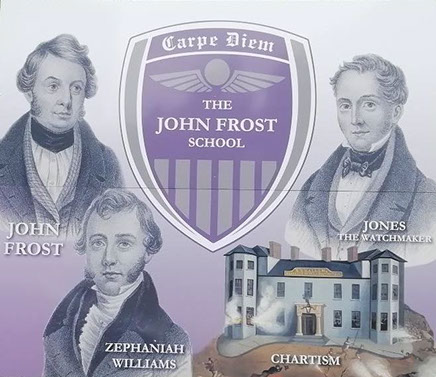
Even before the Rising in the Autumn of 1839, the Monmouthshire Merlin had made its hostility to Chartism clear. That August, the newspaper declared:
‘We have never ceased raising our voices against that Document, impudently and mendaciously termed ‘the People’s Charter.’
As Professor Chris Williams has noted, following the Rising, the local press portrayed John Frost as a madman, while the mayor, Thomas Phillips was treated as a hero, knighted for his role in putting down the Chartists.
Although many of his supporters cheered John Frost through the streets when he returned to Newport in 1856, they were forbidden from using a local theatre for a celebration. When Frost died in 1877 the Monmouthshire Merlin called Chartism ‘a treasonable movement’.
Those in authority were doing their best to get the town to forget Chartism. The 50th anniversary in 1889 was ignored. The Monmouthshire Merlin commented that the only celebration at the Westgate in November was in honour of Guy Fawkes.
By the early 20th century, attitudes were changing. By 1918 five of the six points of the People’s Charter had been granted. Even those who in an earlier age would have opposed Chartism were starting to see it as having been the pioneering part of the movement towards democracy.
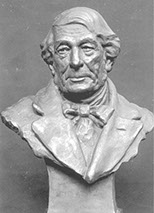 In 1918 Lord Rhondda, the great south Wales coal owner, agreed to unveil a bust of John Frost at Newport Museum (although he died before he could do so).
In 1918 Lord Rhondda, the great south Wales coal owner, agreed to unveil a bust of John Frost at Newport Museum (although he died before he could do so).
CENTENARY
By the time of the centenary of the Rising the change in attitude was clear. In 1938 Newport Council set up a Centenary Celebration Committee under local businessman William Mordey and including representatives of all political parties from Conservative to Communist, plus the editor of the Argus. Chartism was now seen as a way of ‘advertising the town and county’. With the looming threat of war with Nazi Germany and Fascist Italy, it also represented a way of celebrating democracy against dictatorship.
The South Wales Miners Federation (the miners’ union) used the May Day celebrations in 1939 to organise a massive pageant in Abertillery Park which portrayed Chartism as a key part in the rise of the trade union movement. Thousands of participants and spectators were involved, including no less than fifteen choirs and bands.
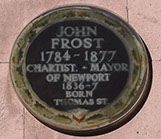 The outbreak of war in 1939 meant that the centenary celebrations had to be scaled back. Nevertheless, Newport Museum staged a special exhibition and over 200 people gathered at the Post Office building in the High Street, close to Frost’s birthplace, where a plaque in his memory was unveiled.
The outbreak of war in 1939 meant that the centenary celebrations had to be scaled back. Nevertheless, Newport Museum staged a special exhibition and over 200 people gathered at the Post Office building in the High Street, close to Frost’s birthplace, where a plaque in his memory was unveiled.
The plaque was placed in a very visible position, above the ‘public stamp machine’ at the main post office in the High Street.
Newport Council ensured the memory was kept alive when the town centre was redeveloped in the 1960s, naming the central square after John Frost and in 1978 commissioning the now-famous mural by Kenneth Budd.


In the 1980s Newport Local History Society organised a plaque commemorating the dead Chartists was erected in St Woolos churchyard and initiated an annual ceremony to place roses on the spot.
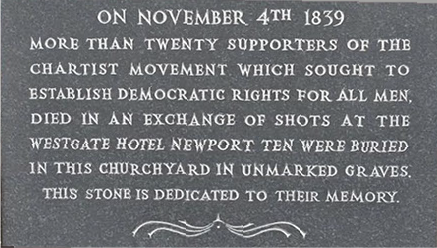
In 1839 most of the local business owners lived in fear of Chartism, but by the 21st century attitudes had changed. In 2008 Ken Ellis, president of Newport Chamber of Trade, argued in the Argus that the Rising was an event ‘which we should really boast about’. He condemned the way the Westgate Hotel had been allowed to fall victim to vandals and graffiti ‘artists’ and argued that more should be done in using Chartism to promote tourism.
The Chartist legacy still has the potential to divide opinion. In 1986 a Conservative councillor opposed plans for the Chartist statue that now stands near the Westgate, claiming that Frost was ‘a miserable little rebel who should have been hung, drawn and quartered’ while in 1994 local historian Haydn Davis questioned the ‘continuous glorification of the riots’. More recently, the removal of the mural to make way for the new Friars Walk shopping centre caused concern among some residents.
Nevertheless, annual celebrations of the Chartists have become firmly established and Chartism has been firmly established as part of the identity of Newport, ‘City of Democracy’. In November 2007, the first Newport Chartist Convention was held at the ‘Stute’ on Stow Hill, next door to the Westgate.
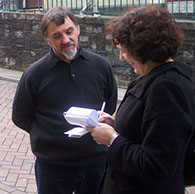 The Convention has been held at various Newport venues, including The University of South Wales, Riverside Campus, John Frost School (twice) and three times at Newport Cathedral (St. Woolos), where in the early days of the Covid pandemic it had been planned to hold the event there yet again, on 5 December, 2020.
The Convention has been held at various Newport venues, including The University of South Wales, Riverside Campus, John Frost School (twice) and three times at Newport Cathedral (St. Woolos), where in the early days of the Covid pandemic it had been planned to hold the event there yet again, on 5 December, 2020.
New Zealand, John Frost descendant, Terry Frost outside the "Stute"
The 2020 Convention will now be marked by three online lectures to be publicly streamed on the 4th, 5th and 6th December.









